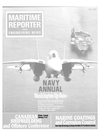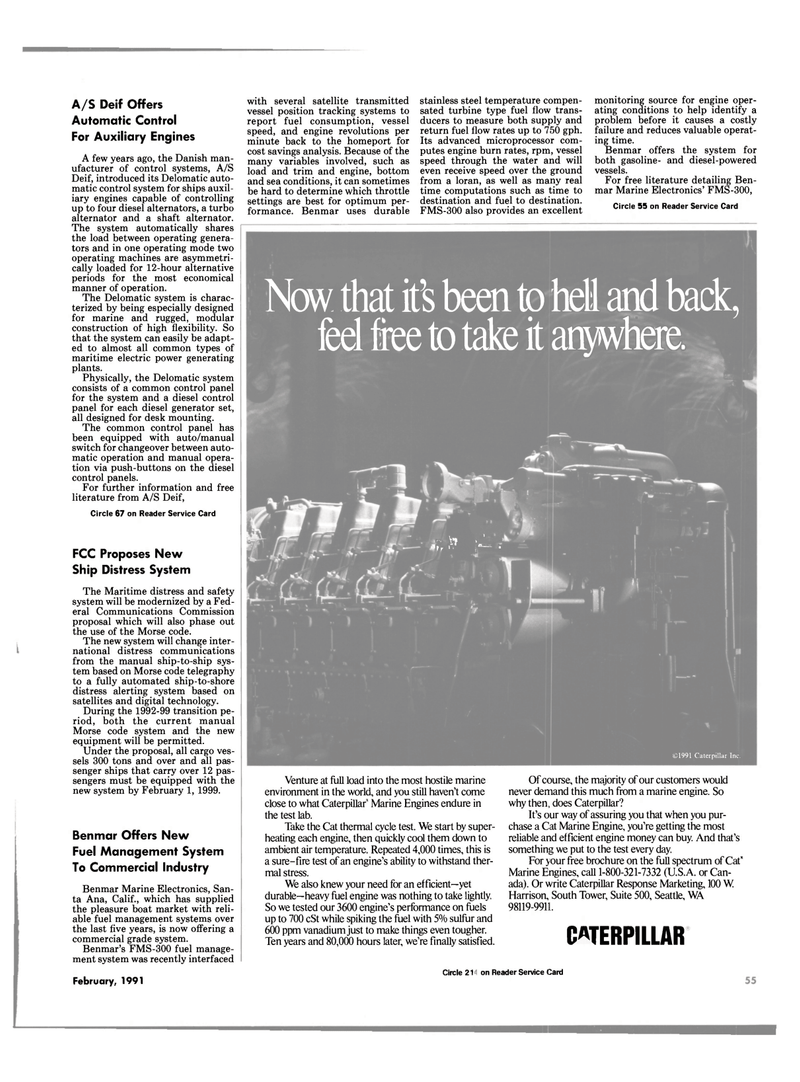
Page 53: of Maritime Reporter Magazine (February 1991)
Read this page in Pdf, Flash or Html5 edition of February 1991 Maritime Reporter Magazine
A/S Deif Offers
Automatic Control
For Auxiliary Engines
A few years ago, the Danish man- ufacturer of control systems, A/S
Deif, introduced its Delomatic auto- matic control system for ships auxil- iary engines capable of controlling up to four diesel alternators, a turbo alternator and a shaft alternator.
The system automatically shares the load between operating genera- tors and in one operating mode two operating machines are asymmetri- cally loaded for 12-hour alternative periods for the most economical manner of operation.
The Delomatic system is charac- terized by being especially designed for marine and rugged, modular construction of high flexibility. So that the system can easily be adapt- ed to almost all common types of maritime electric power generating plants.
Physically, the Delomatic system consists of a common control panel for the system and a diesel control panel for each diesel generator set, all designed for desk mounting.
The common control panel has been equipped with auto/manual switch for changeover between auto- matic operation and manual opera- tion via push-buttons on the diesel control panels.
For further information and free literature from A/S Deif,
Circle 67 on Reader Service Card
FCC Proposes New
Ship Distress System
The Maritime distress and safety system will be modernized by a Fed- eral Communications Commission proposal which will also phase out the use of the Morse code.
The new system will change inter- national distress communications from the manual ship-to-ship sys- tem based on Morse code telegraphy to a fully automated ship-to-shore distress alerting system based on satellites and digital technology.
During the 1992-99 transition pe- riod, both the current manual
Morse code system and the new equipment will be permitted.
Under the proposal, all cargo ves- sels 300 tons and over and all pas- senger ships that carry over 12 pas- sengers must be equipped with the new system by February 1, 1999.
Benmar Offers New
Fuel Management System
To Commercial Industry
Benmar Marine Electronics, San- ta Ana, Calif., which has supplied the pleasure boat market with reli- able fuel management systems over the last five years, is now offering a commercial grade system.
Benmar's FMS-300 fuel manage- ment system was recently interfaced with several satellite transmitted vessel position tracking systems to report fuel consumption, vessel speed, and engine revolutions per minute back to the homeport for cost savings analysis. Because of the many variables involved, such as load and trim and engine, bottom and sea conditions, it can sometimes be hard to determine which throttle settings are best for optimum per- formance. Benmar uses durable stainless steel temperature compen- sated turbine type fuel flow trans- ducers to measure both supply and return fuel flow rates up to 750 gph.
Its advanced microprocessor com- putes engine burn rates, rpm, vessel speed through the water and will even receive speed over the ground from a loran, as well as many real time computations such as time to destination and fuel to destination.
FMS-300 also provides an excellent monitoring source for engine oper- ating conditions to help identify a problem before it causes a costly failure and reduces valuable operat- ing time.
Benmar offers the system for both gasoline- and diesel-powered vessels.
For free literature detailing Ben- mar Marine Electronics' FMS-300,
Circle 55 on Reader Service Card
Now that it's been to hell and back, feel free to take it anywhere. rv \f . ' 1r > ' j*-^ "
Venture at full load into the most hostile marine environment in the world, and you still haven't come close to what Caterpillar" Marine Engines endure in the test lab.
Take the Cat thermal cycle test. We start by super- heating each engine, then quickly cool them down to ambient air temperature. Repeated 4,000 times, this is a sure-fire test of an engine's ability to withstand ther- mal stress.
We also knew your need for an efficient—yet durable—heavy fuel engine was nothing to take lightly.
So we tested our 3600 engine's performance on fuels up to 700 cSt while spiking the fuel with 5% sulfur and 600 ppm vanadium just to make things even tougher.
Ten years and 80,000 hours later, we're finally satisfied. ©1991 Caterpillar Inc.
Of course, the majority of our customers would never demand this much from a marine engine. So why then, does Caterpillar?
It's our way of assuring you that when you pur- chase a Cat Marine Engine, you're getting the most reliable and efficient engine money can buy. And that's something we put to the test every day.
For y our free brochure on the full spectrum of Cat"
Marine Engines, call 1-800-321-7332 (U.S.A. or Can- ada). Or write Caterpillar Response Marketing, 100 W
Harrison, South Tower, Suite 500, Seattle, W\ 98119-9911.
CATERPILLAR
February, 1991
Circle 216 on Reader Service Card 73

 52
52

 54
54
